On the Quasi-Steady Vorticity Balance in the Mature Stage of Hurricane Irma (2017)
Abstract
1. Introduction
2. Vorticity Budget in Isentropic Coordinates
3. Materials and Methods
3.1. Model and Simulation
3.2. Vertical Interpolation
3.3. Hurricane Centre Definition
3.4. Diabatic Heating
3.5. Vorticity Flux Integration
4. Model Validation
5. Results: Vorticity Budget of Irma
6. Discussion and Conclusions
- The outward advective vorticity flux by the mean flow is counteracted by a mean inward vorticity flux due to diabatic heating;
- The magnitudes of these fluxes are largest in the eyewall, and strongly anticorrelated in time;
- The residual vorticity flux, assumed to be dominated by subhourly variations of the flow, has a small effect on the vorticity structure, indicating the importance of the advective and diabatic vorticity fluxes for maintaining the steady state;
- Both the advective and diabatic vorticity fluxes result from the azimuthal-mean flow and are not eddy-driven.
Supplementary Materials
Author Contributions
Funding
Institutional Review Board Statement
Informed Consent Statement
Data Availability Statement
Acknowledgments
Conflicts of Interest
Abbreviations
| ECMWF | European Centre for Medium-Range Weather Forecasts |
| HARMONIE | HIRLAM ALADIN Research on Mesoscale Operational NWP in Euromed |
| HVT | hollow vorticity tower |
| IFS | Integrated Forecast System |
| NWP | numerical weather prediction |
References
- Cangialosi, J.P.; Latto, A.S.; Berg, R. National Hurricane Center Tropical Cyclone Report: Hurricane Irma; National Hurricane Center: Miami, FL, USA, 2018; pp. 1–111.
- Barcikowska, M.; Feser, F.; von Storch, H. Usability of Best Track Data in Climate Statistics in the Western North Pacific. Mon. Weather. Rev. 2012, 140, 2818–2830. [Google Scholar] [CrossRef]
- NOAA National Geophysical Data Center. 2-Minute Gridded Global Relief Data (ETOPO2) v2. 2006. Available online: https://www.ncei.noaa.gov/access/metadata/landing-page/bin/iso?id=gov.noaa.ngdc.mgg.dem:301 (accessed on 8 July 2025).
- Torgerson, W.; Schwendike, J.; Ross, A.; Short, C.J. Intensity fluctuations in Hurricane Irma (2017) during a period of rapid intensification. Weather. Clim. Dyn. 2023, 4, 331–359. [Google Scholar] [CrossRef]
- Fang, J.; Zhang, F. Initial Development and Genesis of Hurricane Dolly (2008). J. Atmos. Sci. 2010, 67, 655–672. [Google Scholar] [CrossRef]
- Raymond, D.J.; López Carrillo, C. The vorticity budget of developing typhoon Nuri (2008). Atmos. Chem. Phys. 2011, 11, 147–163. [Google Scholar] [CrossRef]
- Rantanen, M.; Räisänen, J.; Sinclair, V.A.; Lento, J. The extratropical transition of Hurricane Ophelia (2017) as diagnosed with a generalized omega equation and vorticity equation. Tellus A Dyn. Meteorol. Oceanogr. 2020, 72, 1721215. [Google Scholar] [CrossRef]
- DesRosiers, A.J.; Bell, M.M.; Cha, T.Y. Vertical Vortex Development in Hurricane Michael (2018) during Rapid Intensification. Mon. Weather. Rev. 2022, 150, 99–114. [Google Scholar] [CrossRef]
- Kumar, S.; Verma, S.; Lodh, A. Unravelling the dynamical characteristics of tropical cyclones: Amphan and Nisarga using ERA5 reanalysis. Front. Environ. Sci. 2025, 12, 1475324. [Google Scholar] [CrossRef]
- Paul, D.; Panda, J.; Bhasi, I.; Routray, A. A numerical modeling study on highly intensified tropical cyclones of North Indian Ocean using MPAS-A. Nat. Hazards 2025, 121, 15413–15441. [Google Scholar] [CrossRef]
- Haynes, P.H.; McIntyre, M.E. On the Evolution of Vorticity and Potential Vorticity in the Presence of Diabatic Heating and Frictional or Other Forces. J. Atmos. Sci. 1987, 44, 828–841. [Google Scholar] [CrossRef]
- Haynes, P.H.; McIntyre, M.E. On the Conservation and Impermeability Theorems for Potential Vorticity. J. Atmos. Sci. 1990, 47, 2021–2031. [Google Scholar] [CrossRef]
- Delden, A.V. Adjustment to heating, potential vorticity and cyclogenesis. Q. J. R. Meteorol. Soc. 2003, 129, 3305–3322. [Google Scholar] [CrossRef]
- Lenderink, G.; Holtslag, A.A.M. An updated length-scale formulation for turbulent mixing in clear and cloudy boundary layers. Q. J. R. Meteorol. Soc. 2004, 130, 3405–3427. [Google Scholar] [CrossRef]
- Zhu, P.; Hazelton, A.; Zhang, Z.; Marks, F.D.; Tallapragada, V. The Role of Eyewall Turbulent Transport in the Pathway to Intensification of Tropical Cyclones. J. Geophys. Res. Atmos. 2021, 126, e2021JD034983. [Google Scholar] [CrossRef]
- Bengtsson, L.; Andrae, U.; Aspelien, T.; Batrak, Y.; Calvo, J.; de Rooy, W.; Gleeson, E.; Hansen-Sass, B.; Homleid, M.; Hortal, M.; et al. The HARMONIE–AROME Model Configuration in the ALADIN–HIRLAM NWP System. Mon. Weather. Rev. 2017, 145, 1919–1935. [Google Scholar] [CrossRef]
- de Rooy, W.C.; Siebesma, P.; Baas, P.; Lenderink, G.; de Roode, S.R.; de Vries, H.; van Meijgaard, E.; Meirink, J.F.; Tijm, S.; van ’t Veen, B. Model development in practice: A comprehensive update to the boundary layer schemes in HARMONIE-AROME cycle 40. Geosci. Model Dev. 2022, 15, 1513–1543. [Google Scholar] [CrossRef]
- Pinty, J.P.; Jabouille, P. A mixed-phase cloud parameterization for use in mesoscale non-hydrostatic model: Simulations of a squall line and of orographic precipitations. In Proceedings of the Conference on Cloud Physics, Everett, WA, USA, 17–21 August 1998; pp. 217–220. [Google Scholar]
- Romdhani, O.; Zhang, J.A.; Momen, M. Characterizing the Impacts of Turbulence Closures on Real Hurricane Forecasts: A Comprehensive Joint Assessment of Grid Resolution, Horizontal Turbulence Models, and Horizontal Mixing Length. J. Adv. Model. Earth Syst. 2022, 14, e2021MS002796. [Google Scholar] [CrossRef]
- Artekha, S.N.; Belyan, A.V. On the role of electromagnetic phenomena in some atmospheric processes. Nonlinear Processes Geophys. 2013, 20, 293–304. [Google Scholar] [CrossRef]
- Edouard, S.; Vautard, R.; Brunet, G. On the maintenance of potential vorticity in isentropic coordinates. Q. J. R. Meteorol. Soc. 1997, 123, 2069–2094. [Google Scholar] [CrossRef]
- Kieu, C.Q.; Zhang, D.L. Is the isentropic surface always impermeable to the potential vorticity substance? Adv. Atmos. Sci. 2011, 29, 29–35. [Google Scholar] [CrossRef]
- Shuang, L.; Wei, Z.; Ji-Chen, L.; Han-Cheng, L. The Contribution of Structure and Evolution of Potential Vorticity Tower to the Intensity Change of Hurricane Wilma (2005). Chin. J. Geophys. 2015, 58, 229–242. [Google Scholar] [CrossRef]
- Kossin, J.P.; Eastin, M.D. Two Distinct Regimes in the Kinematic and Thermodynamic Structure of the Hurricane Eye and Eyewall. J. Atmos. Sci. 2001, 58, 1079–1090. [Google Scholar] [CrossRef]
- Rogers, R.; Reasor, P.; Lorsolo, S. Airborne Doppler Observations of the Inner-Core Structural Differences between Intensifying and Steady-State Tropical Cyclones. Mon. Weather. Rev. 2013, 141, 2970–2991. [Google Scholar] [CrossRef]
- Martinez, J.; Bell, M.M.; Vigh, J.L.; Rogers, R.F. Examining Tropical Cyclone Structure and Intensification with the FLIGHT+ Dataset from 1999 to 2012. Mon. Weather. Rev. 2017, 145, 4401–4421. [Google Scholar] [CrossRef]
- Wang, Y. Vortex Rossby Waves in a Numerically Simulated Tropical Cyclone. Part I: Overall Structure, Potential Vorticity, and Kinetic Energy Budgets. J. Atmos. Sci. 2002, 59, 1213–1238. [Google Scholar] [CrossRef]
- García-Franco, J.L.; Schwendike, J. Revisiting gradient wind balance in tropical cyclones using dropsonde observations. Q. J. R. Meteorol. Soc. 2020, 147, 801–824. [Google Scholar] [CrossRef]
- Green, A.; Gopalakrishnan, S.G.; Alaka, G.J.; Chiao, S. Understanding the Role of Mean and Eddy Momentum Transport in the Rapid Intensification of Hurricane Irma (2017) and Hurricane Michael (2018). Atmosphere 2021, 12, 492. [Google Scholar] [CrossRef]
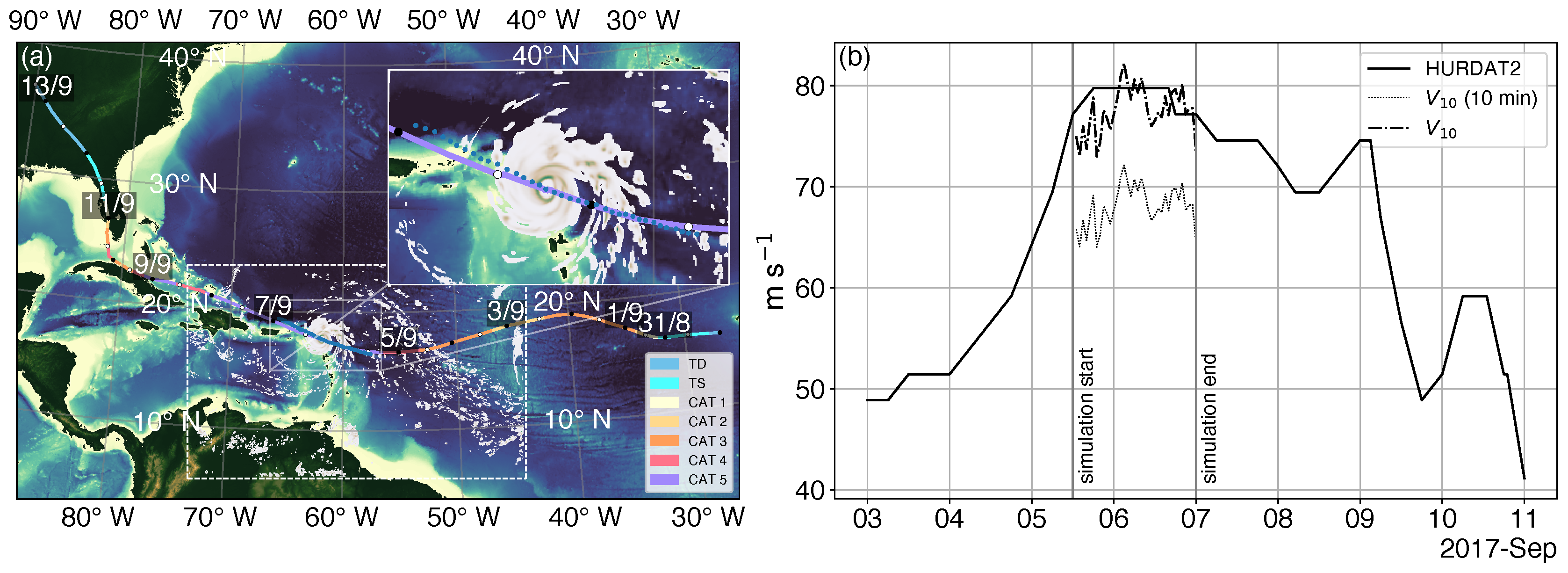

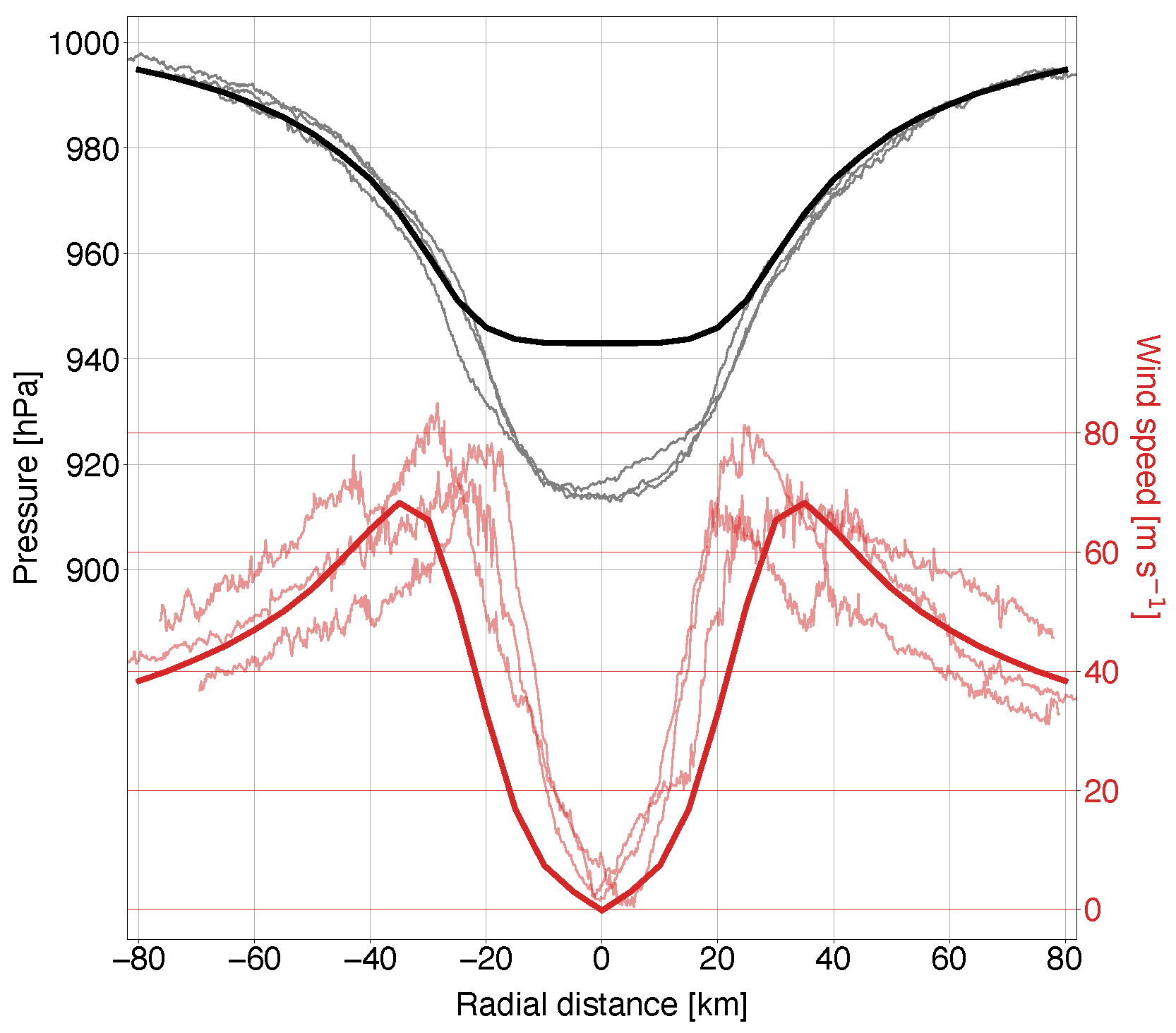
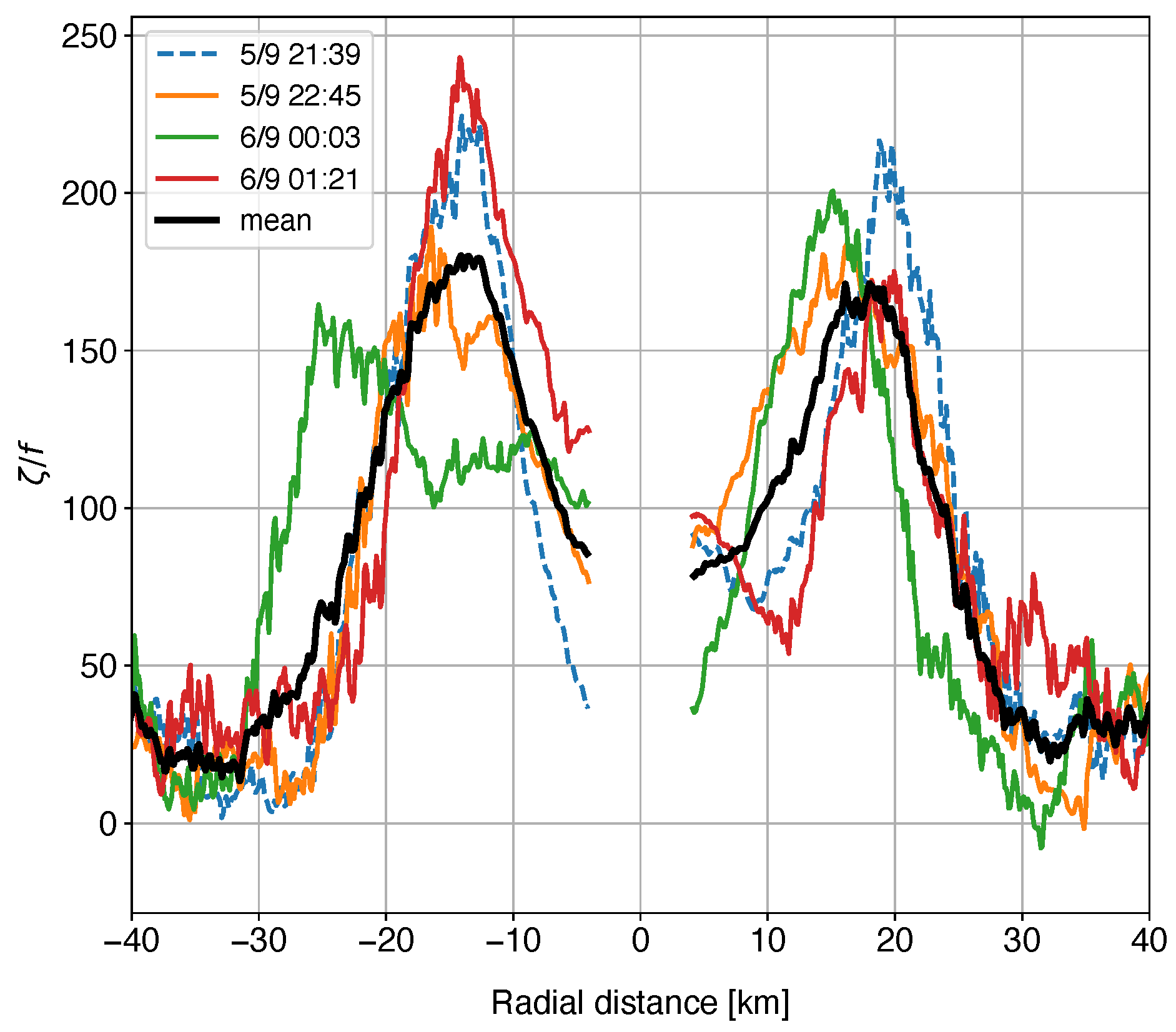
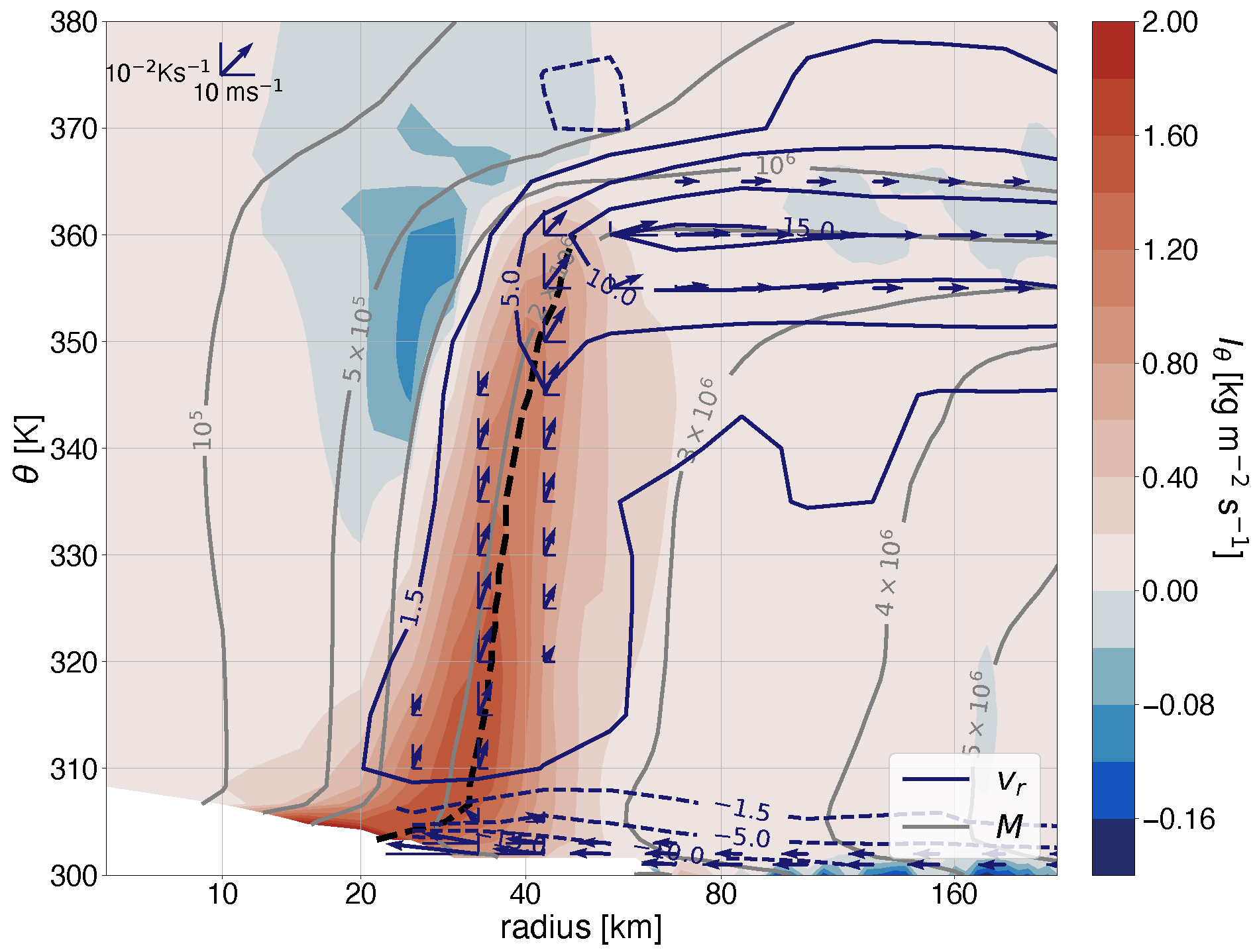

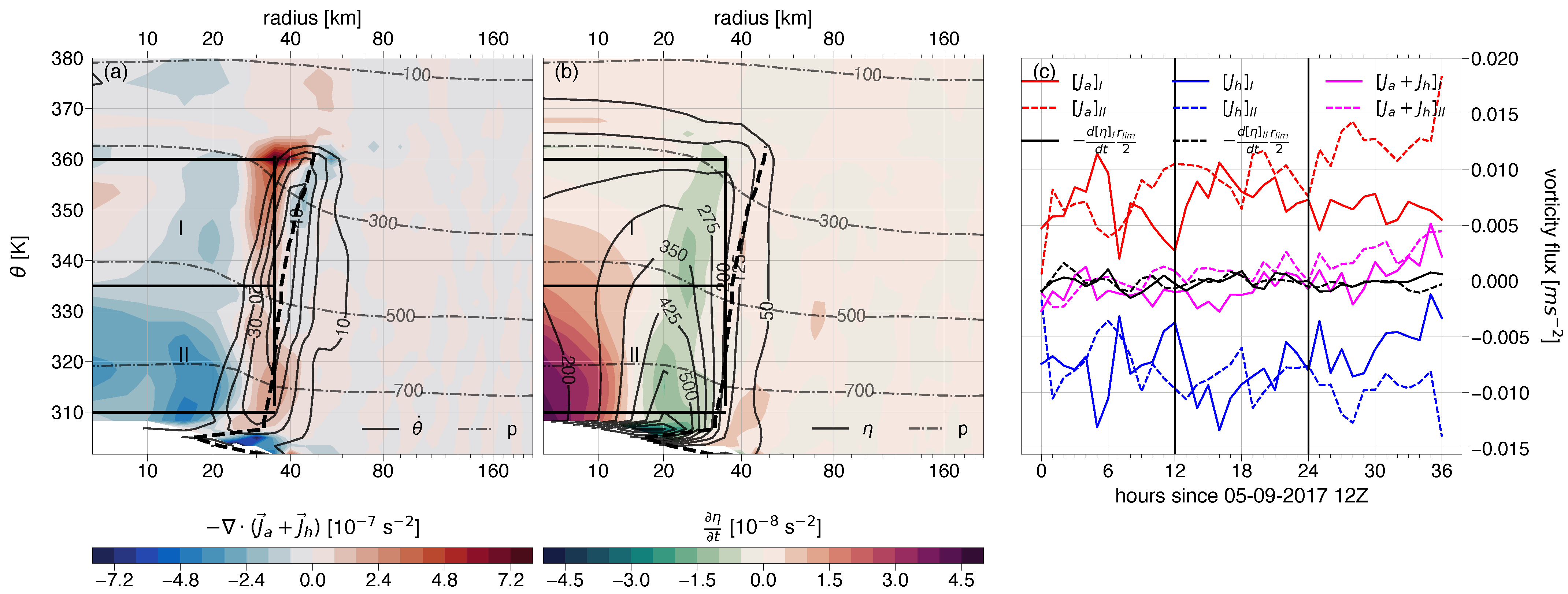

Disclaimer/Publisher’s Note: The statements, opinions and data contained in all publications are solely those of the individual author(s) and contributor(s) and not of MDPI and/or the editor(s). MDPI and/or the editor(s) disclaim responsibility for any injury to people or property resulting from any ideas, methods, instructions or products referred to in the content. |
© 2025 by the authors. Licensee MDPI, Basel, Switzerland. This article is an open access article distributed under the terms and conditions of the Creative Commons Attribution (CC BY) license (https://creativecommons.org/licenses/by/4.0/).
Share and Cite
de Jong, J.; van Delden, A.J.; Baatsen, M.L.J. On the Quasi-Steady Vorticity Balance in the Mature Stage of Hurricane Irma (2017). Atmosphere 2025, 16, 1146. https://doi.org/10.3390/atmos16101146
de Jong J, van Delden AJ, Baatsen MLJ. On the Quasi-Steady Vorticity Balance in the Mature Stage of Hurricane Irma (2017). Atmosphere. 2025; 16(10):1146. https://doi.org/10.3390/atmos16101146
Chicago/Turabian Stylede Jong, Jasper, Aarnout J. van Delden, and Michiel L. J. Baatsen. 2025. "On the Quasi-Steady Vorticity Balance in the Mature Stage of Hurricane Irma (2017)" Atmosphere 16, no. 10: 1146. https://doi.org/10.3390/atmos16101146
APA Stylede Jong, J., van Delden, A. J., & Baatsen, M. L. J. (2025). On the Quasi-Steady Vorticity Balance in the Mature Stage of Hurricane Irma (2017). Atmosphere, 16(10), 1146. https://doi.org/10.3390/atmos16101146





